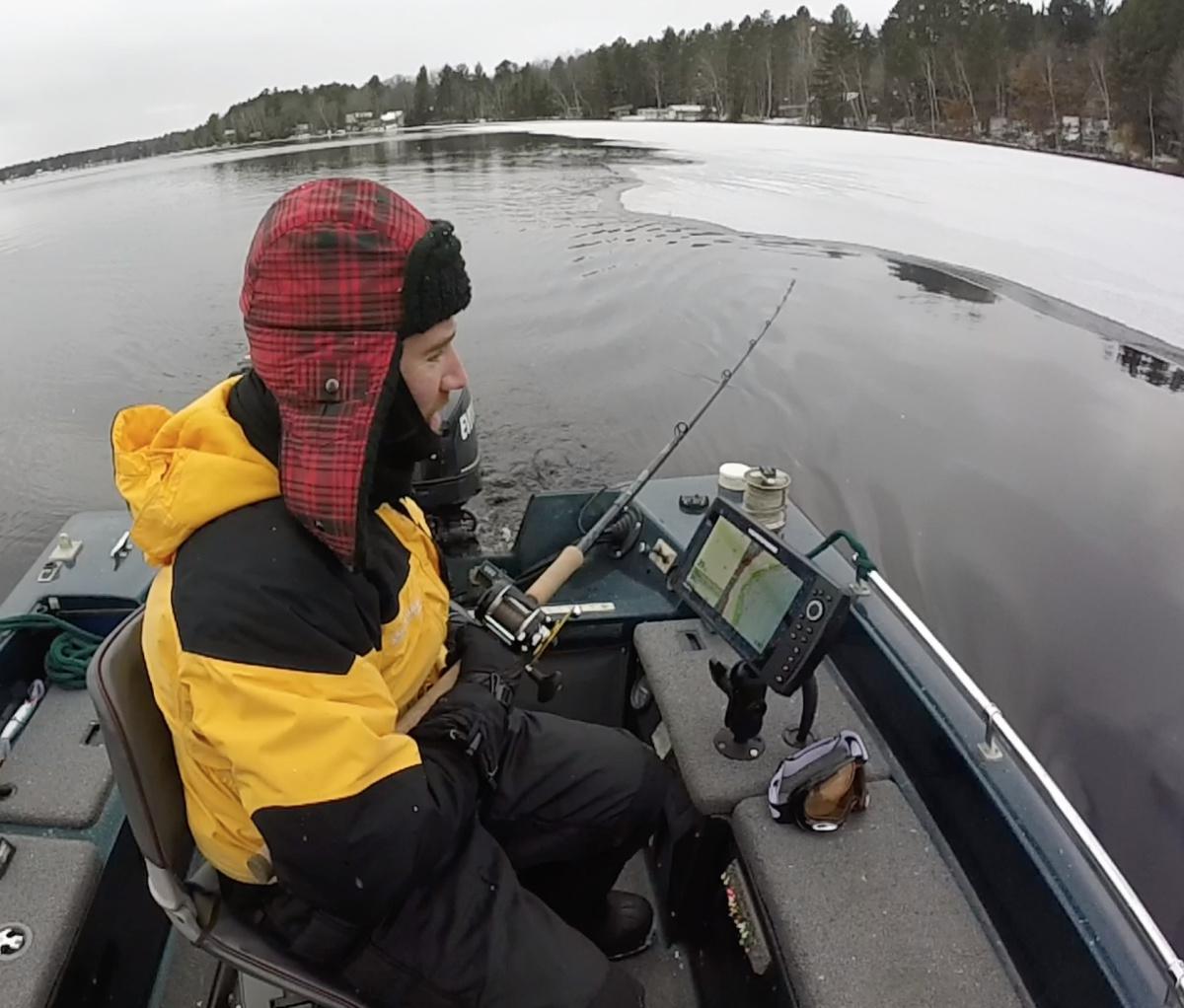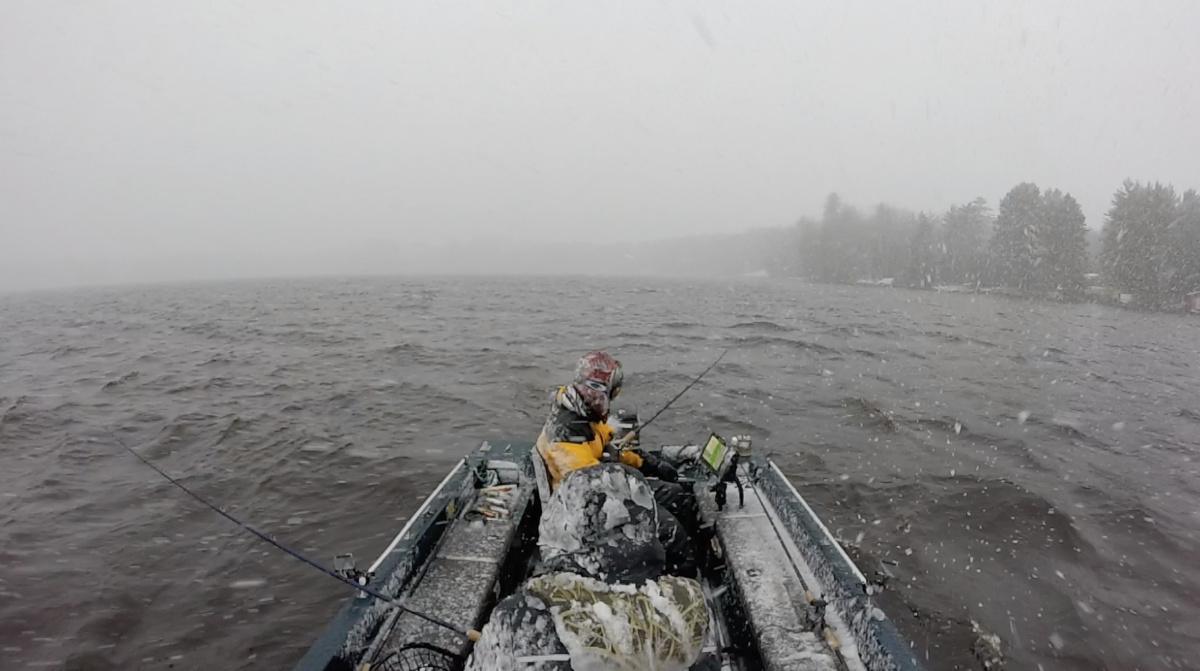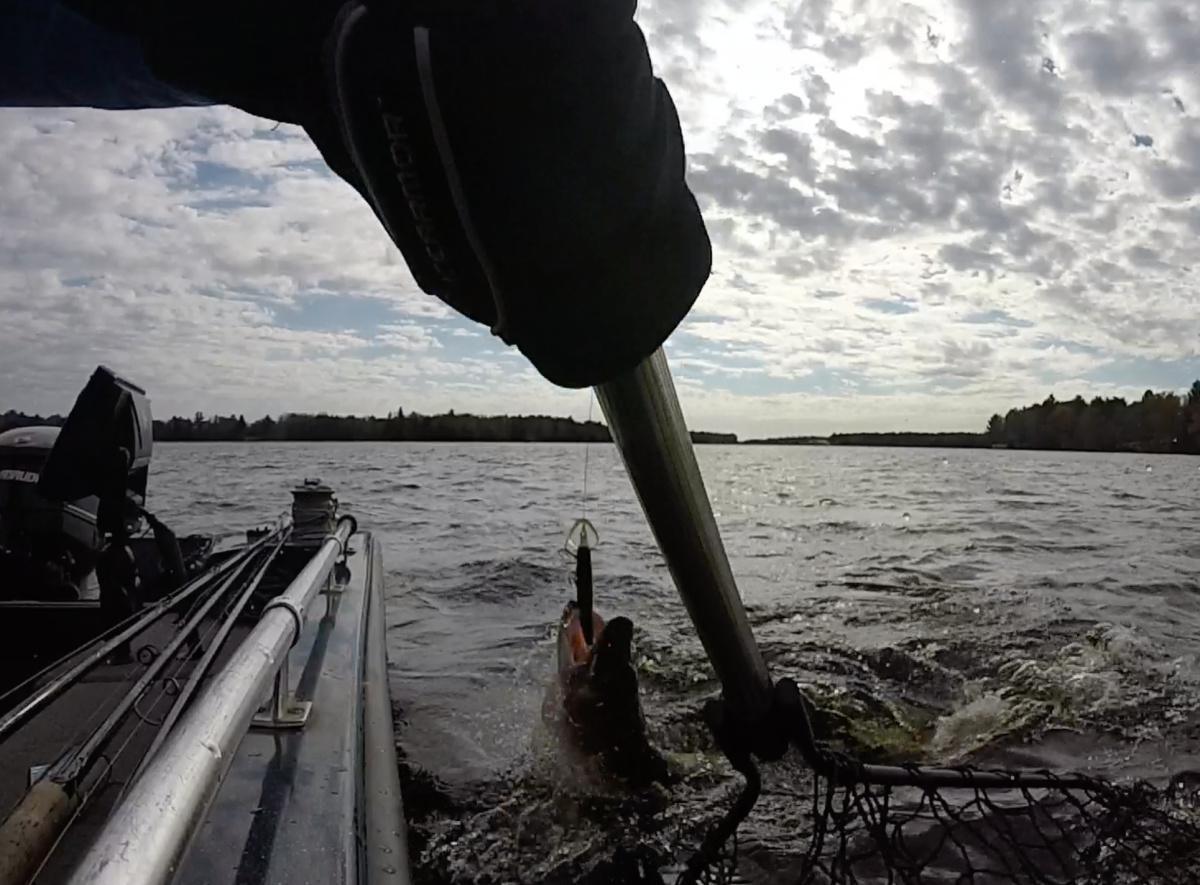When my good friend and long time musky hunting partner Mike Richardson and I woke up early on a Sunday morning in late October we knew it was going to be another very cold day on the water! On our muskie hunt the day before the high temperature during the afternoon solar peak had only been 22 degrees and it looked like not much had changed overnight. A thin layer of snow covered the ground and the feeling of winter lay in the air but none the less, we were fired up to hit the frigid waters again to put ourselves in position to score on a trophy musky!
Now, fishing in the weeks approaching ice-up is not for everyone because of the cold, icy, miserable conditions but the payoff can be huge. In fact many of the largest muskies caught each year are taken during this final stretch and this includes many famous fish, such as the 51 pound 2 oz muskie caught by Tom Gelb on the last day of the season in November of 2006. It is giants like this that provide all of the motivation necessary to brave the conditions and continue hunting until the bitter end!
Biologically speaking, the late-fall period gives you your best chance at netting a super-giant musky from your home waters because of the musky’s increased feeding behavior and fat storage as they prepare for the winter and enter into a semi-hibernative state called torpor. Muskies caught during the late-fall period often display impressive girths and it is the density of this accumulated fat that pushes the needle on the scale!
Now you might be asking, “how are you possibly going to cast lures effectively when the air temperatures are in the mid-twenties?” And that is a great question! The answer to fishing during these extreme conditions is trolling! Now, if you have any preconceived notion that trolling for muskies is boring or, that it does not take skill, then you must keep reading this article because you would be wrong! In fact, I look forward to late-season trolling because of the excitement it provides and as an added bonus, you will have the water all to yourself!
After launching the boat, Richardson setup on the primary breakline and I started us out into the wind with our jointed DepthRaiders on our first trolling pass. The goal is to get the DR to make contact with the bottom of the lake very subtlety and to let it “bounce” along the bottom. The noise, vibration and commotion from working a lure along the bottom in this manner can really trigger an aggressive strike out of the muskies.
As we made our way down the breakline, keeping close to the basin, I made sure to keep our DR’s running near the bottom, clicking and ticking their way along the rocky contour. After only an hour of trolling my DR was stopped violently and for a brief moment, I thought I was stuck on a fish crib. But after a couple of violent headshakes, I knew that this was not a fish crib. It was a giant musky. I yelled to Mike that it was a big fish and to grab the net! After a challenging boatside fight (it was hard seeing with our ski goggles on, which we used for wind protection) we finally got the big musky into the net! Even with the cold wind whipping our faces, Mike and I were sweating with the excitement of the large 48-inch musky that was finally in our grasp! We had done it! After a few photos, we got the underwater camera fired up and filmed the release of this beautiful musky for another Musky Mastery YouTube segment!
Trolling diving crankbaits is your ticket for success during the late fall for a variety of reasons and it is my goal in this article to get you started with the basics so that you can extend your season and have a chance at your biggest fish of the year.
Trolling as a musky fishing tactic is very simple: pull your lure through the water with the power of the boat. You can troll almost any musky lure but during the late-fall period, I prefer to troll deep-diving crankaits, such as the straight or jointed DepthRaiders, that can achieve deep running depths and get down to where the moster muskies are holding. Row-trolling has regained some popularity in recent years but I prefer to troll with the power of my outboard so that I can work into heavy winds with ease. I run an old Ranger 680T (tiller) with a 50 hp Evinrude E-TEC and this is, perhaps, the perfect trolling setup for making precise turns and maneuvers but really any boat and power motor will work well for trolling.
And if you don’t own rod holders or other fancy trolling equipment don’t worry, because I do not use any of that stuff. In fact, I prefer to hold my rod by hand during the trolling process so that I can “feel out” the bottom of the lake and I try to better understand what kind of structure my DepthRaider is being worked over. Any of your regular musky rod setups will work great too but line-counter reels are helpful in building some consistency in your trolling game but again, there are ways around this until you really get into it!
I use my electronics to help locate the forage that muskies are targeting where I am fishing and I look to their depth as a way of determining the running depth I want to get out of my crankbaits. Once I have a general idea of the depth that I believe the muskies are holding at I begin to dial three important things in: boat speed, length of line and line diameter. The line diameter part of the equation is usually kept constant (I generally use 80 lb test Joe Bucher Outdoors Beast Braid which has the diameter of 18 lb test monofilament) but the other two factors are very important to adjust in order to present your crankbait in the strike zone consistently.
The faster your trolling speed and the more line you let out, the deeper your diving crankbait is going to run. Conversely, a slower speed combined with a shorter line will produce a shallower running depth. My goal when trolling traditional structure (not open water structure i.e. baitifish or thermocline) is to allow my DepthRaider to make “contact” with the structure. I want just enough line out at a particular speed so that my DR ticks every so often. As mentioned earlier, this “ticking” tells me that my lure is in the strike zone and also gives me increased information about the structure I am working over via the feel of the bouncing vibrations.
Line-counter reels make the process of getting your crankbait running at a very precise depth easy but if you don’t own a line-counting reel you can still troll with the best of em’! To do this simply cast your crankbait out and begin your trolling run, increasing the amount of line you have out until your lure hits the structure. If you are hitting the bottom too hard just reel some line in until you are barely ticking along. Then, hold on tight!
You can certainly get very fancy and run up an expensive bill quickly to get outfitted for trolling but the equipment I like to use is close to the same that I use for casting, with the exception of the reel. For rods, I like to use any of St. Croix’s 9 foot heavy power, fast action sticks outfitted with a line-counter reel and 80 pound test (18 pound test diameter) Joe Bucher Outdoors Beast Braid. Due to the rugged nature of trolling crankbaits around rocks and all sorts of snags I would not recommend going lighter than this for line weight and additionally, be sure to set your drag a few notches looser for when you hook into cribs and other debris.
I have found success trolling on gin-clear lakes and coffee colored flowages alike and I have caught muskies in both water clarities on straight and jointed model crankbaits. Choosing which style to go with has a lot to do with what the fish tell you they like the best! AKA, get out there and catch some fish to see what produces best on your favorite body of water! I have found that certain colors and body styles work better on certain bodies of water and figuring this out is part of the fun of trolling!
Trolling is a very effective way to fish in the late-fall because it is difficult to cast lures when the air temperatures are below 32 degrees simply from the standpoint of battling freezing fishing line and reels. Equipment failure due to the cold is very common and this can really deter most folks from chasing muskies late into the season. But trolling offers you a method of fishing that allows you to stay bundled up, cover giant expanses of water and to do so while delivering your diving crankbait to the strike zone for a prolonged period of time. The combination of these factors is deadly on muskies and it puts you in position to slip the net under a true giant as ice draws near.
So as the season comes to a close pull your boat out of the garage, snap on a DepthRaider and go trolling for muskies. After you release your muskie post a photo on the Musky360 app and tell us how this article might have helped you or led your in the right direction!
Chas Martin








